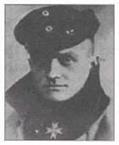The Dreaded Red Baron
“Eddie” Rickenbacker’s World War I kill total ranked him as America’s top pilot. But even a tally of 26 enemy aircraft kills places him far down on the list of pilots that includes aces from other countries. For example, England’s Maj. Edward Mannock downed 72 enemy aircraft, and Belgium’s Capt. Willy Coppens posted 36 kills.
But the greatest aces of the war, by far, were German flyers. Ernst Udet, who was immortalized in the Robert Redford film The Great Waldo Pepper, shot down 62 enemy aircraft, then went on to play a major role in leading Germany’s air force during World War II. And when he wasn’t writing the rules of air combat for German fliers, Oswald Boelcke found time to shoot down 40 enemy aircraft.
But by far the deadliest ace of them all was Manfred von Richthofen, the renowned “Red Baron.” Richthofen (pronounced MKT-hoffin) was a dashing character who became so famous in Germany during the war that he outshone even the brightest stars of the theater and cinema. And he flew in the face of modern stealth tactics by painting his Fokker triplane a bright, menacing red.
|
Manfred von Richthofen was the deadliest pilot in the skies during World War I. |
From White-Knuckle Flyer to Red Baron
Richthofen didn’t start out as the dashing aviator he eventually became. As an airborne observer early in the war, he was a white-knuckle flier. Richthofen overcame his fear and asked to be assigned to flight training, where he proved relatively inept and crashed several times. He barely managed to graduate from the training program. His instructors undoubtedly expected that he would be machine gun fodder for enemy pilots.
After his first combat mission, his instructors worst fears seemed destined to come true. Richthofen took off for a mission over the Western Front, but the untested pilot got turned around and became lost. To find his way home, he was forced to land and ask directions!
|
Turbulence Those long silk scarves looked dashing as they trailed in the wind behind the danng young men in their flying machines. But the gallant accessory was actually bom of necessity. As pilots swiveled their heads to keep their eyes on the enemy, the scarf prevented the heavy fabric of their flight suits from chafing their necks. Flying scarves continued to be used as standard pilot issue і even past World War II. |
|
Turbulence The Red Baron might not have been in fighting condition during the weeks before his death. In addition to shattering his sense of invincibility, his head injury affected his reflexes, perhaps contributing to his demise. |
Richthofen soon flourished in the air, however. Under the tutelage of German air hero Oswald Boelcke, Richthofen gained confidence and quickly began to amass an impressive kill total. Later, when Boelcke (pronounced BELL-key) perished in a midair collision, Richthofen took over the flying unit, which had earned the nickname “Flying Circus” because of the gaudy markings and colors of its planes.
Richthofen’s winning dog fight strategy was simple and twofold: shoot down the planes that would cause the enemy the greatest loss, which Richthofen put into practice by targeting mostly two-seater planes;and never follow the enemy too close to the ground in range of soldiers in the trenches. The second rule was one he later broke, with fatal consequences.














